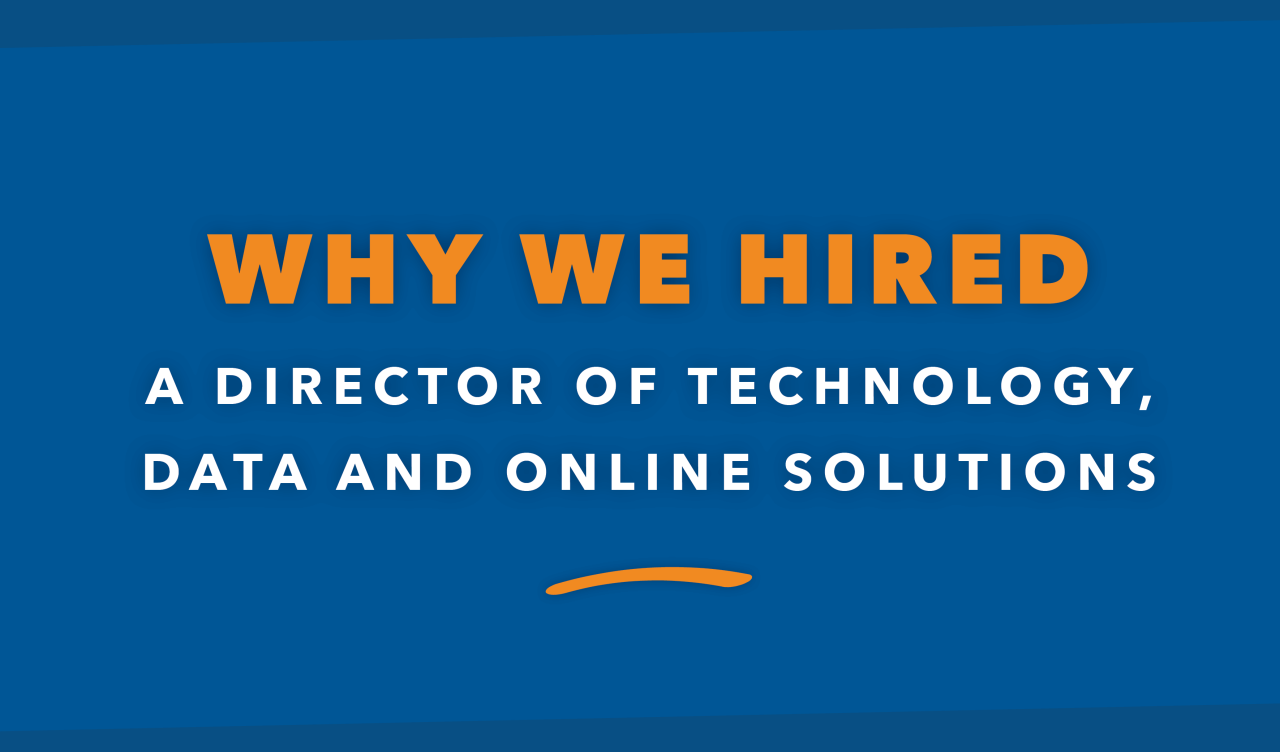Technology Director Jobs: Leading Innovation
Technology Director Jobs: Leading Innovation – In today’s rapidly evolving technological landscape, the role of a Technology Director has become increasingly crucial. These individuals are responsible for shaping the future […]

Technology Director Jobs: Leading Innovation – In today’s rapidly evolving technological landscape, the role of a Technology Director has become increasingly crucial. These individuals are responsible for shaping the future of organizations by driving innovation, overseeing complex technology infrastructure, and ensuring seamless operations.
Technology Directors are highly sought after in various industries, from healthcare and finance to education and entertainment. They are strategic thinkers, adept at managing teams, and possess a deep understanding of the latest technological advancements. Their ability to bridge the gap between business goals and technical solutions is paramount to an organization’s success.
Role Overview

A Technology Director is a high-level executive responsible for the overall technology strategy and implementation within an organization. They play a pivotal role in driving innovation, ensuring seamless technology operations, and aligning technology with business goals.
Technology Directors typically have a strong background in IT, coupled with leadership and business acumen. They are responsible for overseeing a team of IT professionals, managing technology budgets, and making strategic decisions about technology investments.
Typical Career Path
The path to becoming a Technology Director often involves a progression through various IT roles, gaining experience in different areas of technology and leadership.
A common trajectory includes:
- Starting as an IT specialist in a specific area, such as software development, network administration, or cybersecurity.
- Progressing to a management role, leading a team of IT professionals within a specific department or function.
- Taking on broader responsibilities as an IT manager or director, overseeing multiple IT teams and departments.
- Finally, assuming the role of Technology Director, leading the overall technology strategy and vision for the organization.
Industries Where Technology Directors Are Highly Sought After
Technology Directors are in high demand across various industries, particularly those that heavily rely on technology for their operations and growth.
Some of the industries where Technology Directors are highly sought after include:
- Technology companies: These companies, such as software developers, hardware manufacturers, and cloud service providers, require strong leadership to manage their complex technology infrastructure and drive innovation.
- Financial services: Financial institutions rely heavily on technology for trading, risk management, and customer service. Technology Directors play a crucial role in ensuring secure and efficient operations in this highly regulated industry.
- Healthcare: The healthcare industry is undergoing a digital transformation, with increasing adoption of electronic health records, telemedicine, and data analytics. Technology Directors are essential in leading this transformation and ensuring patient data security.
- Retail: E-commerce and omnichannel retail strategies are driving the need for technology directors who can manage complex online platforms, supply chain logistics, and customer data.
- Manufacturing: Smart factories and Industry 4.0 initiatives are creating a demand for technology directors who can oversee the integration of automation, robotics, and data analytics in manufacturing processes.
Responsibilities and Duties

The Technology Director holds a pivotal position within an organization, responsible for overseeing and guiding all aspects of technology strategy, implementation, and operations. This role requires a blend of technical expertise, strategic thinking, and leadership skills to ensure the organization’s technological success and alignment with its overall business goals.
Key Responsibilities
The Technology Director’s responsibilities are multifaceted and encompass a wide range of areas, including:
| Responsibility | Description |
|---|---|
| Strategic Planning and Vision | Developing and executing a comprehensive technology strategy that aligns with the organization’s business objectives, encompassing technology roadmap, infrastructure planning, and resource allocation. |
| Technology Infrastructure Management | Overseeing the organization’s IT infrastructure, including hardware, software, networks, and data centers, ensuring optimal performance, security, and scalability. |
| Technology Implementation and Deployment | Leading the implementation and deployment of new technologies and systems, ensuring seamless integration with existing infrastructure and processes. |
| Team Leadership and Management | Building, leading, and managing a high-performing IT team, fostering collaboration, innovation, and professional development. |
| Budget Management and Financial Planning | Developing and managing the technology budget, ensuring cost-effectiveness and return on investment for technology initiatives. |
| Vendor Management and Partnerships | Negotiating contracts, managing relationships, and collaborating with technology vendors and partners to secure optimal solutions and services. |
| Risk Management and Security | Identifying, assessing, and mitigating technology risks, implementing robust security measures to protect data, systems, and networks. |
| Compliance and Governance | Ensuring compliance with relevant industry standards, regulations, and legal requirements related to technology and data security. |
| Innovation and Emerging Technologies | Staying abreast of emerging technologies and trends, evaluating their potential impact on the organization, and exploring opportunities for innovation and competitive advantage. |
| Communication and Collaboration | Effectively communicating technology strategies, updates, and insights to stakeholders, including senior management, employees, and customers. |
Decision-Making Process
The Technology Director’s decision-making process typically involves a structured approach to ensure informed and strategic choices. This process can be illustrated through a flowchart:
Step 1: Identify the Problem or Opportunity: The process begins with clearly defining the issue or opportunity that requires a technology-related decision. This could range from addressing a security vulnerability to exploring a new technology for business improvement.
Step 2: Gather Information and Data: Thorough research and data collection are crucial to inform the decision. This involves gathering insights from various sources, including internal stakeholders, industry experts, and technology vendors.
Step 3: Analyze Options and Evaluate Risks: Once sufficient information is gathered, the Technology Director analyzes available options, considering their potential benefits, drawbacks, costs, and risks. This step may involve conducting feasibility studies, cost-benefit analyses, and risk assessments.
Technology Director jobs are in high demand, particularly in regions known for their innovation and technological advancements. The Midwest, often associated with traditional industries, is experiencing a surge in tech-driven growth, with companies embracing midwestern technology to drive efficiency and competitiveness.
This shift creates exciting opportunities for technology directors to spearhead digital transformation initiatives and shape the future of businesses in the region.
Step 4: Consult with Stakeholders: Involving relevant stakeholders, such as senior management, IT team members, and business users, ensures alignment and buy-in for the chosen solution. This step allows for open discussion, feedback, and collaboration.
Step 5: Make the Decision and Communicate: Based on the gathered information, analysis, and stakeholder input, the Technology Director makes a well-informed decision. This decision is then clearly communicated to all relevant parties, outlining the rationale and implementation plan.
Step 6: Implement and Monitor: The chosen solution is implemented, and its progress is closely monitored. This involves tracking key performance indicators, addressing any challenges, and making necessary adjustments to ensure successful implementation and achievement of desired outcomes.
Industry Trends and Challenges
The technology landscape is in a constant state of flux, driven by rapid advancements in artificial intelligence, cloud computing, and data analytics. These trends present both opportunities and challenges for Technology Directors, who are responsible for navigating these changes and ensuring their organizations remain competitive.
Emerging Technologies and Their Impact, Technology director jobs
Technology Directors must stay abreast of emerging technologies and assess their potential impact on their organizations. For example, the rise of artificial intelligence (AI) is transforming industries by automating tasks, improving decision-making, and creating new products and services. Technology Directors must understand how AI can be leveraged to improve efficiency, enhance customer experiences, and develop new revenue streams.
- Artificial Intelligence (AI): AI is rapidly transforming various industries by automating tasks, improving decision-making, and creating new products and services. Technology Directors need to evaluate how AI can be leveraged to improve efficiency, enhance customer experiences, and develop new revenue streams.
- Cloud Computing: Cloud computing offers organizations greater flexibility, scalability, and cost-effectiveness. Technology Directors need to develop strategies for migrating applications and data to the cloud while ensuring security and compliance.
- Cybersecurity: Cybersecurity threats are becoming increasingly sophisticated, requiring Technology Directors to invest in robust security measures and implement proactive threat detection and response strategies.
- Internet of Things (IoT): The proliferation of connected devices is generating vast amounts of data, creating opportunities for organizations to gain insights and optimize operations. Technology Directors must develop strategies for managing and analyzing IoT data.
Challenges Facing Technology Directors
Technology Directors face numerous challenges in today’s dynamic environment.
- Keeping Up with Rapid Technological Advancements: The pace of technological innovation is accelerating, making it challenging for Technology Directors to stay current with the latest trends and technologies. They need to constantly evaluate emerging technologies and their potential impact on their organizations.
- Managing Cybersecurity Risks: Cybersecurity threats are becoming increasingly sophisticated, requiring Technology Directors to invest in robust security measures and implement proactive threat detection and response strategies. They must stay informed about emerging threats and vulnerabilities and adapt their security posture accordingly.
- Balancing Innovation and Operational Efficiency: Technology Directors must strike a balance between investing in innovative technologies and maintaining operational efficiency. They need to prioritize projects that deliver tangible business value while ensuring that existing systems remain reliable and secure.
- Attracting and Retaining Skilled Talent: The demand for skilled technology professionals is high, making it challenging for Technology Directors to attract and retain top talent. They need to offer competitive compensation and benefits packages, create a positive work environment, and provide opportunities for professional development.
Adapting to Challenges
Technology Directors are adapting to these challenges in various ways:
- Embracing Continuous Learning: Technology Directors must engage in continuous learning to stay ahead of the curve. They can attend industry conferences, read technical publications, and participate in online courses to expand their knowledge and skills.
- Building Strategic Partnerships: Technology Directors can leverage strategic partnerships with technology vendors, consulting firms, and other organizations to access expertise and resources that are not available in-house. This can help them stay informed about emerging trends and technologies and access cutting-edge solutions.
- Fostering a Culture of Innovation: Technology Directors must create a culture that encourages experimentation, collaboration, and continuous improvement. This involves providing employees with the resources and support they need to explore new ideas and develop innovative solutions.
Compensation and Job Outlook: Technology Director Jobs

Technology Directors play a crucial role in shaping the technological landscape of organizations, and their expertise is highly valued in today’s digital world. As such, they command competitive salaries and enjoy excellent career prospects.
This section explores the compensation and job outlook for Technology Directors, providing insights into salary ranges, growth potential, and emerging trends in the industry.
Average Salary Ranges
The average salary for Technology Directors varies depending on factors such as location, industry, company size, and experience level. Here’s a glimpse into salary ranges in major tech hubs:
- San Francisco Bay Area: $180,000 – $300,000 per year
- New York City: $160,000 – $270,000 per year
- Seattle: $170,000 – $280,000 per year
- London: £120,000 – £200,000 per year
- Toronto: C$140,000 – C$240,000 per year
Job Market Outlook for Technology Directors
The job market for Technology Directors is robust and projected to grow steadily in the coming years. The increasing reliance on technology across industries is driving demand for skilled professionals who can lead and manage complex technology initiatives.
- Growth Potential: The U.S. Bureau of Labor Statistics projects a 13% growth in computer and information technology occupations from 2020 to 2030, significantly faster than the average for all occupations.
- Emerging Trends: The demand for Technology Directors with expertise in emerging technologies such as artificial intelligence (AI), cloud computing, cybersecurity, and data analytics is particularly high.
- Industry-Specific Trends: The healthcare, finance, and retail industries are actively seeking Technology Directors with specific industry knowledge and experience to drive digital transformation initiatives.
Compensation and Career Progression Opportunities in Various Industries
Compensation and career progression opportunities for Technology Directors can vary significantly across different industries. Here’s a comparative overview:
- Technology Industry: Technology companies typically offer the highest salaries for Technology Directors, with ample opportunities for career advancement into senior leadership roles. Examples include companies like Google, Amazon, and Microsoft.
- Financial Services: Financial institutions are investing heavily in technology, creating strong demand for Technology Directors with expertise in areas such as fintech, data security, and regulatory compliance. Examples include banks, investment firms, and insurance companies.
- Healthcare: The healthcare industry is undergoing a digital transformation, driving demand for Technology Directors with expertise in areas such as electronic health records, telemedicine, and data analytics. Examples include hospitals, pharmaceutical companies, and medical device manufacturers.
End of Discussion
As technology continues to advance at an unprecedented pace, the role of a Technology Director will only become more significant. They are the architects of the future, driving digital transformation and ensuring that organizations remain competitive in a rapidly changing world. By understanding the trends, challenges, and opportunities in the field, aspiring Technology Directors can position themselves for success and make a lasting impact on the industry.









